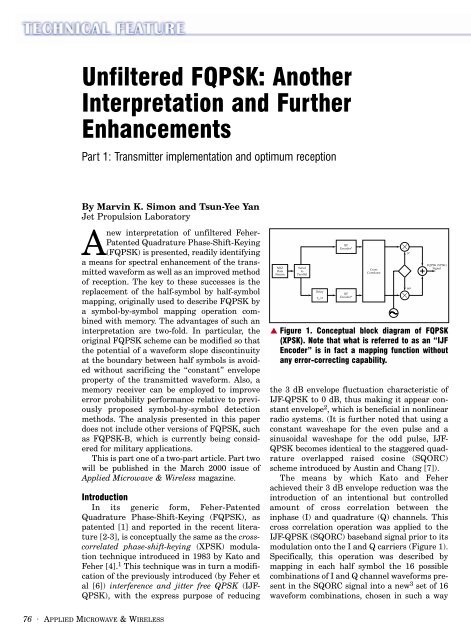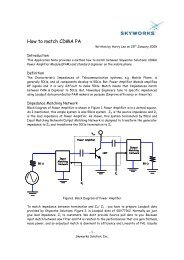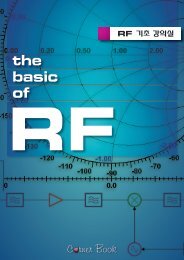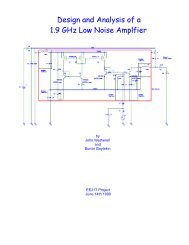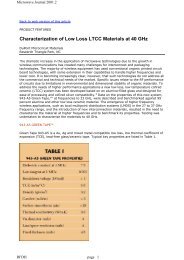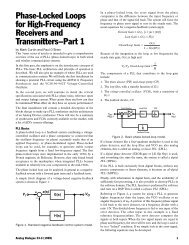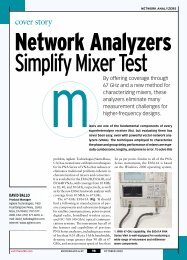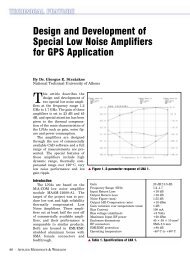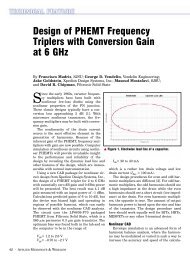Unfiltered FQPSK: Another Interpretation and Further Enhancements
Unfiltered FQPSK: Another Interpretation and Further Enhancements
Unfiltered FQPSK: Another Interpretation and Further Enhancements
You also want an ePaper? Increase the reach of your titles
YUMPU automatically turns print PDFs into web optimized ePapers that Google loves.
<strong>Unfiltered</strong> <strong>FQPSK</strong>: <strong>Another</strong><br />
<strong>Interpretation</strong> <strong>and</strong> <strong>Further</strong><br />
<strong>Enhancements</strong><br />
Part 1: Transmitter implementation <strong>and</strong> optimum reception<br />
By Marvin K. Simon <strong>and</strong> Tsun-Yee Yan<br />
Jet Propulsion Laboratory<br />
Anew interpretation of unfiltered Feher-<br />
Patented Quadrature Phase-Shift-Keying<br />
(<strong>FQPSK</strong>) is presented, readily identifying<br />
a means for spectral enhancement of the transmitted<br />
waveform as well as an improved method<br />
of reception. The key to these successes is the<br />
replacement of the half-symbol by half-symbol<br />
mapping, originally used to describe <strong>FQPSK</strong> by<br />
a symbol-by-symbol mapping operation combined<br />
with memory. The advantages of such an<br />
interpretation are two-fold. In particular, the<br />
original <strong>FQPSK</strong> scheme can be modified so that<br />
the potential of a waveform slope discontinuity<br />
at the boundary between half symbols is avoided<br />
without sacrificing the “constant” envelope<br />
property of the transmitted waveform. Also, a<br />
memory receiver can be employed to improve<br />
error probability performance relative to previously<br />
proposed symbol-by-symbol detection<br />
methods. The analysis presented in this paper<br />
does not include other versions of <strong>FQPSK</strong>, such<br />
as <strong>FQPSK</strong>-B, which is currently being considered<br />
for military applications.<br />
This is part one of a two-part article. Part two<br />
will be published in the March 2000 issue of<br />
Applied Microwave & Wireless magazine.<br />
Introduction<br />
In its generic form, Feher-Patented<br />
Quadrature Phase-Shift-Keying (<strong>FQPSK</strong>), as<br />
patented [1] <strong>and</strong> reported in the recent literature<br />
[2-3], is conceptually the same as the crosscorrelated<br />
phase-shift-keying (XPSK) modulation<br />
technique introduced in 1983 by Kato <strong>and</strong><br />
Feher [4]. 1 This technique was in turn a modification<br />
of the previously introduced (by Feher et<br />
al [6]) interference <strong>and</strong> jitter free QPSK (IJF-<br />
QPSK), with the express purpose of reducing<br />
▲ Figure 1. Conceptual block diagram of <strong>FQPSK</strong><br />
(XPSK). Note that what is referred to as an “IJF<br />
Encoder” is in fact a mapping function without<br />
any error-correcting capability.<br />
the 3 dB envelope fluctuation characteristic of<br />
IJF-QPSK to 0 dB, thus making it appear constant<br />
envelope 2 , which is beneficial in nonlinear<br />
radio systems. (It is further noted that using a<br />
constant waveshape for the even pulse <strong>and</strong> a<br />
sinusoidal waveshape for the odd pulse, IJF-<br />
QPSK becomes identical to the staggered quadrature<br />
overlapped raised cosine (SQORC)<br />
scheme introduced by Austin <strong>and</strong> Chang [7]).<br />
The means by which Kato <strong>and</strong> Feher<br />
achieved their 3 dB envelope reduction was the<br />
introduction of an intentional but controlled<br />
amount of cross correlation between the<br />
inphase (I) <strong>and</strong> quadrature (Q) channels. This<br />
cross correlation operation was applied to the<br />
IJF-QPSK (SQORC) baseb<strong>and</strong> signal prior to its<br />
modulation onto the I <strong>and</strong> Q carriers (Figure 1).<br />
Specifically, this operation was described by<br />
mapping in each half symbol the 16 possible<br />
combinations of I <strong>and</strong> Q channel waveforms present<br />
in the SQORC signal into a new 3 set of 16<br />
waveform combinations, chosen in such a way<br />
76 · APPLIED MICROWAVE & WIRELESS
that the cross correlator output is time continuous <strong>and</strong><br />
has unit (normalized) envelope 4 at all I <strong>and</strong> Q uniform<br />
sampling instants.<br />
Because the cross correlation mapping is based on a<br />
half symbol characterization of the SQORC signal, there<br />
is no guarantee that the slope of the cross correlator output<br />
waveform is continuous at the half symbol transition<br />
points. In fact, we will show that for a r<strong>and</strong>om data<br />
input sequence, such a discontinuity in slope occurs one<br />
quarter of the time.<br />
It is well known that the rate at which the side lobes<br />
of a modulation’s power spectral density (PSD) roll off<br />
with frequency is related to the smoothness of the<br />
underlying waveforms that generate it. That is, the<br />
more derivatives of a waveform that are continuous, the<br />
faster its Fourier transform decays with frequency.<br />
Thus, since the first derivative of the <strong>FQPSK</strong> waveform<br />
is discontinuous (at half symbol transition instants) on<br />
the average one quarter of the time, one can anticipate<br />
that an improvement in PSD rolloff could be achieved if<br />
the <strong>FQPSK</strong> cross correlation mapping could be modified<br />
so the first derivative is always continuous.<br />
Restructuring the cross correlation mapping into a<br />
symbol-by-symbol representation will place the slope<br />
discontinuity referred to above in evidence <strong>and</strong> will be<br />
particularly helpful in suggesting a means to eliminate<br />
it. This representation also has the advantage that it can<br />
be described directly in terms of the data transitions on<br />
the I <strong>and</strong> Q channels. Thus, the combination of IJF<br />
encoder <strong>and</strong> cross correlator can be replaced simply by a<br />
single modified cross correlator. The replacement of the<br />
conventional <strong>FQPSK</strong> cross correlator by this modified<br />
cross correlator, which eliminates the slope discontinuity,<br />
leads to what we shall refer to as enhanced <strong>FQPSK</strong>.<br />
We will show that not only does enhanced <strong>FQPSK</strong> have<br />
a better PSD (in the sense of reduced out-of-b<strong>and</strong> energy)<br />
than conventional <strong>FQPSK</strong>, but from a modulation<br />
symmetry st<strong>and</strong>point, it is a more logical choice.<br />
A further <strong>and</strong> more important advantage of the reformulation<br />
as a symbol-by-symbol mapping is the ability<br />
to design a receiver of <strong>FQPSK</strong> or enhanced <strong>FQPSK</strong> that<br />
specifically exploits the correlation introduced into the<br />
modulation scheme to significantly improve power efficiency<br />
or equivalently, error probability performance.<br />
Such a receiver, which takes a form analogous to those<br />
used for trellis-coded modulations, will be shown to yield<br />
significant performance improvement over receivers<br />
that employ symbol-by-symbol detection, thus ignoring<br />
the inherent memory of the modulation.<br />
Review of IJF-QPSK <strong>and</strong> SQORC<br />
The IJF-QPSK scheme (alternately called <strong>FQPSK</strong>-1)<br />
is based on defining waveforms s o (t) <strong>and</strong> s e (t), which are<br />
respectively odd <strong>and</strong> even functions of time over the<br />
symbol interval –T s /2 ≤ t ≤ T s /2, <strong>and</strong> then using these<br />
<strong>and</strong> their negatives –s o (t), –s e (t) as a 4-ary signal set for<br />
▲ Figure 2a. Inphase IJF encoder output.<br />
▲ Figure 2b. Quadrature phase IJF encoder output.<br />
transmission in accordance with the values of successive<br />
pairs of data symbols in each of the I <strong>and</strong> Q arms.<br />
Specifically, if d In denotes the I channel data symbols in<br />
the interval, (n–½)T s ≤ t ≤ (n+½)T s , then the transmitted<br />
waveform x I (t) in this same interval would be determined<br />
as follows:<br />
x I (t)=s e (t–nT s )= ∆ s 0 (t–nT s ) if d I,n–1 =1, d I,n =1<br />
x I (t)=–s e (t–nT s )= ∆ s 1 (t–nT s ) if d I,n–1 =–1, d I,n =–1<br />
x I (t)=s o (t–nT s )= ∆ s 2 (t–nT s ) if d I,n–1 =–1, d I,n =1<br />
x I (t)=–s o (t–nT s ) = ∆ s 3 (t–nT s ) if d I,n–1 =1, d I,n =–1<br />
The Q channel waveform x Q (t) would be generated by<br />
the same mapping as in (1) using instead the Q channel<br />
data symbols {d Qn } <strong>and</strong> then delaying the resulting<br />
waveform by one half a symbol. If the odd <strong>and</strong> even<br />
waveforms s o (t) <strong>and</strong> s e (t) are defined by<br />
se() t = 1, −Ts / 2≤ t ≤Ts<br />
/ 2<br />
πt<br />
so( t) = sin , −Ts<br />
/ 2≤ t ≤Ts<br />
/ 2<br />
T<br />
s<br />
(1)<br />
(2)<br />
78 · APPLIED MICROWAVE & WIRELESS
then typical waveforms for the I <strong>and</strong> Q IJF encoder outputs<br />
are illustrated in Figure 2.<br />
An identical modulation to x I (t) (<strong>and</strong> likewise for<br />
x Q (t)) generated from the combination of (1) <strong>and</strong> (2) can<br />
be obtained directly from the binary data sequence {d In }<br />
itself, without the need for defining a 4-ary mapping<br />
based on the transition properties of the sequence. In<br />
particular, if we define the two-symbol wide raised<br />
cosine pulse shape<br />
pt ( ) = sin<br />
then the I modulation<br />
x () t = ∑ d p( t−<br />
nT)<br />
I<br />
will be identical to that generated by the above IJF<br />
scheme. Similarly,<br />
⎛ ⎞<br />
x () t = d p( t n T)<br />
Q ∑ − +<br />
Qn<br />
s<br />
n=−∞<br />
⎝ 2⎠<br />
∞ 1<br />
(a)<br />
(c)<br />
∞<br />
n=−∞<br />
( )<br />
⎛ π t+<br />
T /<br />
⎜<br />
⎝ 2T<br />
2 s 2<br />
In<br />
s<br />
⎞<br />
⎟, −Ts<br />
/ 2≤ t ≤3Ts<br />
/ 2<br />
⎠<br />
s<br />
(b)<br />
(d)<br />
(3)<br />
(4)<br />
(5)<br />
would also be identical to that generated by the above<br />
IJF scheme. A quadrature modulation scheme formed<br />
from x I (t) of (4) <strong>and</strong> x Q (t) of (5) is precisely what Austin<br />
<strong>and</strong> Chang [7] referred to as SQORC modulation, namely,<br />
independent I <strong>and</strong> Q modulations with overlapping<br />
raised cosine pulses on each channel. The resulting carrier<br />
modulated waveform is described by<br />
xt () = x1()cos t ωct+<br />
xQ()sin<br />
t ωct<br />
Symbol-by-symbol cross correlator mapping for <strong>FQPSK</strong><br />
Before revealing the modification of <strong>FQPSK</strong>, which<br />
results in a transmitted signal having a continuous first<br />
derivative, we first recast the original characterization<br />
of <strong>FQPSK</strong> in terms of a cross correlation operation performed<br />
on the pair of IJF encoder outputs every half<br />
symbol interval into a mapping performed directly on<br />
the input I <strong>and</strong> Q data sequences every full symbol interval.<br />
To do this, we define sixteen waveforms<br />
s i (t);i=0,1,2,...,15 over the interval –T s /2 ≤ t ≤ Τ s /2,<br />
which collectively form a transmitted signaling set for<br />
the I <strong>and</strong> Q channels. The particular I <strong>and</strong> Q waveforms<br />
chosen for any particular T s -sec signaling interval on<br />
each channel depends on the most recent data transition<br />
on that channel as well as the two most recent successive<br />
transitions on the other channel (Figure 3).<br />
s () t = A, −T /<br />
s<br />
2≤ t ≤ T /<br />
s<br />
2, s () t = −s () t<br />
0 8 0<br />
⎧A, −T / 2≤ s<br />
t ≤0<br />
⎪<br />
s()<br />
1<br />
t = ⎨<br />
2 πt<br />
,<br />
⎪<br />
1−( 1−<br />
A) cos , 0≤ t ≤T<br />
/ 2<br />
s<br />
⎩<br />
Ts<br />
s ()<br />
9<br />
t =−s()<br />
1<br />
t<br />
⎧<br />
2 π t<br />
⎪1−( 1−<br />
A)cos<br />
, −Ts<br />
/ 2≤ t ≤0<br />
s () t =<br />
T<br />
2 ⎨<br />
s<br />
,<br />
⎪<br />
⎩A. 0≤<br />
t ≤Ts<br />
/ 2<br />
s10() t =−s2()<br />
t<br />
2 πt<br />
s ( t) = −( − A)cos , −Ts<br />
/ ≤ t ≤Ts<br />
/<br />
3<br />
1 1 2 2 ,<br />
Ts<br />
s () t =−s () t<br />
11<br />
3<br />
(6)<br />
(7a)<br />
(e)<br />
(g)<br />
(f)<br />
(h)<br />
▲ Figure 3. <strong>FQPSK</strong> full-symbol waveforms: (a) s 0 (t) = –s 8 (t)<br />
vs. t; (b) s 1 (t) = –s 9 (t) vs t; (c) s 2 (t) = –s 10 (t) vs. t; (d) s 3 (t)<br />
= –s 11 (t) vs. t; (e) s 4 (t) = –s 12 (t) vs. t; (f) s 5 (t) = –s 13 (t)<br />
vs. t; (g) s 6 (t) = –s 14 (t); <strong>and</strong> (h) s 7 (t) = –s 15 (t) vs. t.<br />
πt<br />
s4( t) = Asin , −Ts<br />
/ 2≤ t ≤Ts<br />
/ 2<br />
T<br />
s<br />
12<br />
s<br />
() t =−s () t<br />
⎧ πt<br />
Asin , −Ts<br />
/ 2≤ t ≤0<br />
⎪ Ts<br />
s5()<br />
t = ⎨<br />
⎪ πt<br />
sin , 0≤<br />
t ≤Ts<br />
/ 2<br />
⎩⎪<br />
Ts<br />
s () t =−s () t<br />
13<br />
⎧ πt<br />
sin , − Ts<br />
/ 2 ≤ t ≤0<br />
⎪ Ts<br />
s6()<br />
t = ⎨<br />
⎪ πt<br />
Asin , 0 ≤ t ≤Ts<br />
/ 2<br />
⎩⎪<br />
Ts<br />
s () t =−s () t<br />
πt<br />
s7<br />
( t) = sin , −Ts<br />
/ 2≤ t ≤Ts<br />
/ 2<br />
T<br />
s<br />
14<br />
15<br />
s<br />
5<br />
6<br />
4<br />
() t =−s () t<br />
7<br />
,<br />
,<br />
,<br />
,<br />
(7b)<br />
80 · APPLIED MICROWAVE & WIRELESS
Note that for any value of A other<br />
then unity, s 6 (t) <strong>and</strong> s 7 (t) as well as<br />
their negatives s 13 (t) <strong>and</strong> s 14 (t), will<br />
have a discontinuous slope at their<br />
midpoints (i.e., at t=0), whereas the<br />
remaining twelve waveforms all<br />
have a continuous slope throughout<br />
their defining interval. Also, all 16<br />
waveforms have zero slope at their<br />
endpoints, <strong>and</strong> thus concatenation<br />
of any pair of these will not result in<br />
a slope discontinuity.<br />
Next, we define the mapping<br />
function for the baseb<strong>and</strong> I-channel<br />
transmitted waveform y 1 (t)=s I (t) in<br />
the nth signaling interval (n–½)T s ≤<br />
t ≤ (n+½)T s , in terms of the transition<br />
properties of the I <strong>and</strong> Q data<br />
symbol sequences {d In } <strong>and</strong> {d Qn },<br />
respectively.<br />
8a<br />
I. If d I,n–1 =1, d I,n =1 (no transition<br />
on the I sequence, both data bits<br />
positive), then<br />
A. y I (t)=s 0 (t–nT s ) if d Q,n–2 , d Q,n–1 ,<br />
results in no transition <strong>and</strong> d Q,n–1 ,<br />
d Q,n results in no transition.<br />
B. y I (t)=s 1 (t–nT s ) if d Q,n–2 , d Q,n–1<br />
results in no transition <strong>and</strong> d Q,n–1 ,<br />
d Q,n results in a transition (positive<br />
or negative).<br />
C. y I (t)=s 2 (t–nT s ) if d Q,n–2 , d Q,n–1<br />
results in a transition (positive or<br />
negative) <strong>and</strong> d Q,n–1 , d Q,n results in<br />
no transition.<br />
D. y I (t)=s 3 (t–nT s ) if d Q,n–2 , d Q,n–1<br />
results in a transition (positive or<br />
negative) <strong>and</strong> d Q,n–1 , d Q,n results in a<br />
transition (positive or negative).<br />
8b<br />
II. If d I,n–1 =–1, d I,n =1 (a positive<br />
going transition on the I sequence),<br />
then<br />
A. y I (t)=s 4 (t–nT s ) if d Q,n–2 , d Q,n–1<br />
results in no transition <strong>and</strong> d Q,n–1 ,<br />
d Q,n results in no transition.<br />
B. y I (t)=s 5 (t–nT s ) if d Q,n–2 , d Q,n–1<br />
results in no transition <strong>and</strong> d Q,n–1 ,<br />
d Q,n results in a transition (positive<br />
or negative).<br />
C . y I (t)=s 6 (t–nT s ) if d Q,n–2 , d Q,n–1<br />
results in a transition (positive or<br />
negative) <strong>and</strong> d Q,n–1 , d Q,n results in<br />
no transition.<br />
D. y I (t)=s 7 (t–nT s ) if d Q,n–2 , d Q,n–1<br />
results in a transition (positive or<br />
negative) <strong>and</strong> d Q,n–1 , d Q,n results in a<br />
transition (positive or negative).<br />
8c<br />
III. If d I,n–1 =–1, d I,n =–1(no transition<br />
on the I sequence, both data bits<br />
negative), then<br />
A. y I (t)=s 8 (t–nT s ) if d Q,n–2 , d Q,n–1<br />
results in no transition <strong>and</strong> d Q,n–1 ,<br />
d Q,n results in no transition.<br />
B. y I (t)=s 9 (t–nT s ) if d Q,n–2 , d Q,n–1<br />
results in no transition <strong>and</strong> d Q,n–1 ,<br />
d Q,n results in a transition (positive<br />
or negative).<br />
C. y I (t)=s 10 (t–nT s ) if d Q,n–2 , d Q,n–1<br />
results in a transition (positive or<br />
negative) <strong>and</strong> d Q,n–1 , d Q,n results in<br />
no transition.<br />
D. y I (t)=s 11 (t–nT s ) if d Q,n–2 ,<br />
82 · APPLIED MICROWAVE & WIRELESS
d Q,n–1 results in a transition (positive<br />
or negative) <strong>and</strong> d Q,n–1 , d Q,n<br />
results in a transition (positive or<br />
negative).<br />
8d<br />
IV. If d I,n–1 =1, d I,n =–1 (a negative<br />
going transition on the I sequence),<br />
then<br />
A. y I (t)=s 12 (t–nT s ) if d Q,n–2 , d Q,n–1<br />
results in no transition <strong>and</strong> d Q,n–1 ,<br />
d Q,n results in no transition.<br />
B. y I (t)=s 13 (t–nT s ) if d Q,n–2 , d Q,n–1<br />
results in no transition <strong>and</strong> d Q,n–1 ,<br />
d Q,n results in a transition (positive<br />
or negative).<br />
C. y I (t)=s 14 (t–nT s ) if d Q,n–2 , d Q,n–1<br />
results in a transition (positive or<br />
negative) <strong>and</strong> d Q,n–1 , d Q,n results in<br />
no transition.<br />
D. y I (t)=s 15 (t–nT s ) if d Q,n–2 , d Q,n–1<br />
results in a transition (positive or<br />
negative) <strong>and</strong> d Q,n–1 , d Q,n results in a<br />
transition (positive or negative).<br />
Making use of the signal properties<br />
in (7a) <strong>and</strong> (7b), the mapping<br />
conditions in (8a-8d) for the I channel<br />
baseb<strong>and</strong> output can be summarized<br />
in a concise form (Table 1). A<br />
similar construction for the baseb<strong>and</strong><br />
Q-channel transmitted waveform<br />
y Q (t) = s Q (t–T s /2) in the nth<br />
signaling interval nT s ≤ t ≤ (n+1)T s<br />
in terms of the transition properties<br />
of the I <strong>and</strong> Q data symbol<br />
sequences {d in } <strong>and</strong> {d Qn }, respectively,<br />
can be obtained analogous to<br />
(8a-d). The results are summarized<br />
in Table 2. Note that the subscript i<br />
of the transmitted signal s i (t–nT s ) or<br />
s i (t–(n+½)T s ) as appropriate is the<br />
binary coded decimal (BCD) equivalent<br />
of the three transitions.<br />
Applying the mappings in Tables<br />
1 <strong>and</strong> 2 to the I <strong>and</strong> Q data<br />
sequences of Figure 2 produces the<br />
identical I <strong>and</strong> Q baseb<strong>and</strong> transmitted<br />
signals to those that would be<br />
produced by passing the I <strong>and</strong> QIJF<br />
encoder outputs of this figure<br />
through the cross-correlator (half<br />
symbol mapping) of the <strong>FQPSK</strong><br />
(XPSK) scheme as described in [4]<br />
(Figure 4). Thus, we conclude that<br />
for arbitrary I <strong>and</strong> Q input sequences,<br />
<strong>FQPSK</strong> can alternately be generated<br />
by the symbol-by-symbol mappings<br />
of Tables 1 <strong>and</strong> 2 as applied to<br />
these sequences.<br />
A new <strong>and</strong> improved <strong>FQPSK</strong><br />
As discussed above, the symbolby-symbol<br />
mapping representation<br />
of <strong>FQPSK</strong> identifies the fact that<br />
four out of the sixteen possible<br />
transmitted waveforms, namely<br />
s 5 (t), s 6 (t), s 13 (t) <strong>and</strong> s 14 (t) have a<br />
slope discontinuity at their midpoint.<br />
Thus, for r<strong>and</strong>om I <strong>and</strong> Q data<br />
symbol sequences, on the average<br />
the transmitted <strong>FQPSK</strong> waveform<br />
will likewise have a slope discontinuity<br />
at one quarter of the uniform<br />
sampling time instants. To prevent<br />
this from occurring, we now redefine<br />
FEBRUARY 2000 · 83
▲ Figure 4a. Inphase <strong>FQPSK</strong> (XPSK) output.<br />
▲ Figure 4b. Quadrature phase <strong>FQPSK</strong> (XPSK) output.<br />
these four transmitted signals in a manner analogous to<br />
s 1 (t), s 2 (t), s 9 (t) <strong>and</strong> s 10 (t), namely,<br />
⎧ πt<br />
2 πt<br />
sin + ( 1− A)sin , −Ts<br />
/ 2≤ t ≤0<br />
⎪ Ts<br />
Ts<br />
s5()<br />
t = ⎨<br />
⎪ πt<br />
sin , 0 ≤ t ≤Ts<br />
/ 2<br />
⎩⎪<br />
Ts<br />
s () t =−s () t<br />
s<br />
6<br />
13<br />
⎧ πt<br />
sin , −Ts<br />
/ 2≤ t ≤0<br />
⎪ Ts<br />
() t ⎨<br />
⎪ πt<br />
2 πt<br />
sin −( 1 − A)sin , 0 ≤ t ≤Ts<br />
/ 2<br />
⎩⎪<br />
Ts<br />
Ts<br />
s 14 () t =−s () t<br />
6<br />
5<br />
Note that the signals s 5 (t), s 6 (t), s 13 (t) <strong>and</strong> s 14 (t) as<br />
defined in (9) do not have a slope discontinuity at their<br />
midpoint nor, for that matter, anywhere else in the<br />
defining interval. Also, the zero slope at their endpoints<br />
d In – d I,n–1 d Q,n–1 – d Q,n–2 d Qn – d Q,n–1 s I (t)<br />
2 2 2<br />
0 0 0 d In s 0 (t–nT s )<br />
0 0 1 d In s 1 (t–nT s )<br />
0 1 0 d In s 2 (t–nT s )<br />
0 1 1 d In s 3 (t–nT s )<br />
1 0 0 d In s 4 (t–nT s )<br />
1 0 1 d In s 5 (t–nT s )<br />
1 1 0 d In s 6 (t–nT s )<br />
1 1 1 d In s 7 (t–nT s )<br />
▲ Table 1. Mapping for inphase (I)-channel baseb<strong>and</strong> signal<br />
y I (t) in in the interval (n–½)T s ≤ t ≤ (n+½)T s .<br />
,<br />
,<br />
(9)<br />
has been preserved. Thus, using (9) in place of the corresponding<br />
signals of (7b) will result in a modified<br />
<strong>FQPSK</strong> signal that has no slope discontinuity anywhere<br />
in time regardless of the value of A. Figure 5 illustrates<br />
a comparison of the signal s 6 (t) of (9) with that of (7b)<br />
for a value of A=1√2. Figure 6 illustrates the power spectral<br />
density of conventional <strong>FQPSK</strong> <strong>and</strong> its enhancement<br />
obtained by using the waveforms of (9) as replacements<br />
for those in (7b). The significant improvement in<br />
spectral rolloff rate is clear from a comparison of the<br />
two.<br />
As it currently st<strong>and</strong>s, the signal set chosen for<br />
enhanced <strong>FQPSK</strong> has a symmetry property for s 0 (t),<br />
s 1 (t), s 2 (t) <strong>and</strong> s 3 (t) that is not present for s 4 (t), s 5 (t), s 6 (t)<br />
<strong>and</strong> s 7 (t). In particular, s 1 (t) <strong>and</strong> s 2 (t) are each composed<br />
of one half of s 0 (t) <strong>and</strong> one half of s 3 (t), i.e., the portion<br />
of s 1 (t) from t = –T s /2 to t = 0 is the same as that of s 0 (t),<br />
whereas the portion of s 1 (t) from t = 0 to t = T s /2 is the<br />
same as that of s 3 (t), <strong>and</strong> vice versa for s 2 (t). To achieve<br />
the same symmetry property for s 4 (t) – s 7 (t), one would<br />
have to reassign s 4 (t) as<br />
d Qn – d Q,n–1 d I,n – d I,n–1 d I,n+1 – d I,n s I (t)<br />
2 2 2<br />
0 0 0 d Qn s 0 (t–nT s )<br />
0 0 1 d Qn s 1 (t–nT s )<br />
0 1 0 d Qn s 2 (t–nT s )<br />
0 1 1 d Qn s 3 (t–nT s )<br />
1 0 0 d Qn s 4 (t–nT s )<br />
1 0 1 d Qn s 5 (t–nT s )<br />
1 1 0 d Qn s 6 (t–nT s )<br />
1 1 1 d Qn s 7 (t–nT s )<br />
▲ Table 2. Mapping for quadrature (Q)-channel baseb<strong>and</strong><br />
signal y Q (t) in the interval nT s ≤ t ≤ (n+1)T s .<br />
84 · APPLIED MICROWAVE & WIRELESS
▲ Figure 5. Original <strong>and</strong> new <strong>FQPSK</strong> shapes.<br />
▲ Figure 6. Power spectra of conventional <strong>and</strong> enhanced <strong>FQPSK</strong>: (a)<br />
without SSPA; <strong>and</strong> (b) with SSPA.<br />
s<br />
4<br />
⎧ πt<br />
2 πt<br />
sin + ( 1− A)sin , −Ts<br />
/ 2≤ t ≤0<br />
⎪ Ts<br />
Ts<br />
() t = ⎨<br />
,<br />
⎪ πt<br />
2 πt<br />
sin −( 1− A)sin , 0 ≤ t ≤Ts<br />
/ 2<br />
⎩⎪<br />
Ts<br />
Ts<br />
() t =−s () t<br />
s 12<br />
4<br />
(10)<br />
This minor change, which produces a complete symmetry<br />
in the waveform set, has an advantage from the<br />
st<strong>and</strong>point of hardware implementation <strong>and</strong> produces a<br />
negligible change in spectral properties of the transmitted<br />
waveform. Nevertheless, for the remainder of the<br />
discussion, we shall ignore this minor change <strong>and</strong><br />
assume the version of enhanced <strong>FQPSK</strong> first introduced<br />
in this section.<br />
<strong>Interpretation</strong> of <strong>FQPSK</strong> as a trellis-coded modulation<br />
The I <strong>and</strong> Q mappings given in Tables 1 <strong>and</strong> 2 are<br />
alternately described in terms of the (0,1) representation<br />
of the I <strong>and</strong> Q data symbols <strong>and</strong> their transitions.<br />
Specifically, define<br />
D In = ∆ (1–d In )/2, D Qn = ∆ (1−d Qn )/2 (11)<br />
which both range on the set (0,1). Then, defining the<br />
BCD representation of the indices i <strong>and</strong> j by<br />
with<br />
3<br />
i= I3<br />
× 2 + I2<br />
× 2 + I1<br />
× 2 + I0<br />
× 2<br />
3<br />
2<br />
1<br />
j= Q × 2 + Q × 2 + Q × 2 + Q × 2<br />
3<br />
I = DQn ⊕ D Q D D<br />
0 Q n− , =<br />
I n<br />
⊕<br />
, 1 0 , + 1 In<br />
I = DQn , −<br />
⊕ DQn , −<br />
, Q = DIn⊕ DIn<br />
, −<br />
= I<br />
I =<br />
2<br />
D ⊕<br />
In<br />
D ,<br />
I n 1<br />
Q =<br />
2<br />
D ⊕<br />
Qn<br />
D =<br />
, −<br />
Q,<br />
n−1 I0<br />
I = D , Q = D<br />
1 1 2 1 1 2<br />
3 In 3<br />
2<br />
2<br />
Qn<br />
1<br />
(12)<br />
(13)<br />
we have y I (t)=s i (t–nT s ) <strong>and</strong> y Q (t)=s j (t–(n+½)T s ). That<br />
is, in each symbol interval ((n–½)T s ≤ t ≤ (n+½)T s for<br />
y I (t) <strong>and</strong> nT s ≤ t ≤ (n+1)T s for y Q (t)), the I <strong>and</strong> Q channel<br />
baseb<strong>and</strong> signals are each chosen from a set of 16<br />
1<br />
0<br />
0<br />
0<br />
▲ Figure 7. Alternate implementation of <strong>FQPSK</strong> baseb<strong>and</strong> signals.<br />
▲ Figure 8. 16-state trellis diagram for <strong>FQPSK</strong>.<br />
86 · APPLIED MICROWAVE & WIRELESS
signals, s i (t), i=0,1,...,15, in<br />
accordance with the 4-bit<br />
BCD representations of<br />
their indices defined by (12)<br />
together with (13). A graphical<br />
illustration of the implementation<br />
of this mapping<br />
is given in Figure 7.<br />
<strong>Another</strong> interpretation<br />
of the mapping in Figure 7<br />
is as a 16-state trellis code<br />
with two binary (0,1) inputs<br />
D I,n+1 , D Qn , <strong>and</strong> two waveform<br />
outputs s i (t), s j (t),<br />
where the state is defined<br />
by the 4-bit sequence D In ,<br />
D I,n–1 , D Q,n–1 , D Q,n–2 . The<br />
trellis is illustrated in<br />
Figure 8, <strong>and</strong> the transition<br />
mapping is given in<br />
Appendix 1. In this table,<br />
the entries in the column labeled “input” correspond to<br />
the values of the two input bits that result in the transition,<br />
while the entries in the column “output” correspond<br />
to the subscripts i <strong>and</strong> j of the pair of symbol<br />
waveforms s i (t), s j (t) that are outputted.<br />
To compute the performance of this trellis coded modulation<br />
(TCM), we need to determine the minimum<br />
Euclidean distance between pairs of error event paths<br />
that leave a given state <strong>and</strong> first return to that or another<br />
state a number of branches later. The smallest length<br />
error event for which there are at least two paths that<br />
start in one state <strong>and</strong> remerge in the same or another<br />
state is three branches. For each of the 16 starting<br />
states, there are exactly four such error event paths<br />
that remerge in each of the 16 end states. Figures 9a<br />
<strong>and</strong> 9b are examples of these error event paths corresponding<br />
to the first two states, respectively, for the<br />
case where the start <strong>and</strong> end states are the same. The<br />
remaining length three error event paths for states 9-<br />
16 are the mirror images of the ones for states 1-8<br />
(for example, Figure 9c, which should be compared<br />
with Figure 9a). Also, the paths for states 9-16 will<br />
have identical Euclidean distance properties to those<br />
for states 1-8, since the output symbols along their<br />
branches will be the negatives of those along their<br />
mirror images. Figures 10a <strong>and</strong> 10b are examples of<br />
the groups of four error event paths that start in a<br />
given state <strong>and</strong> remerge in another state. A similar<br />
mirror image symmetry exists for these groups of<br />
paths <strong>and</strong> thus once again it is sufficient to consider<br />
only the first eight starting states.<br />
It is important to note that the trellis code defined<br />
by the mapping in Appendix 1 is not uniform, e.g., it<br />
is not sufficient to consider only the all zeros path as<br />
the transmitted path in computing the minimum<br />
(a) (b) (c)<br />
▲ Figure 9. (a) Paths of length 3 branches starting <strong>and</strong> ending in State 1; (b) paths of length<br />
3 branches starting <strong>and</strong> ending in State 2; <strong>and</strong> (c) paths of length 3 branches starting <strong>and</strong><br />
ending in State 16.<br />
Euclidean distance. Rather, one must consider all possible<br />
pairs of error event paths starting from each of the<br />
16 states (eight states is sufficient in view of the abovementioned<br />
distance symmetry properties) <strong>and</strong> ending in<br />
each of the 16 states. This determines the pair having<br />
the minimum Euclidean distance.<br />
The following example illustrates the procedure for<br />
the groups of paths that start <strong>and</strong> end in the same state.<br />
Upon examination of the squared Euclidean distance<br />
between all pairs of paths in the above-mentioned figures,<br />
it can be shown that the minimum of this distance,<br />
2<br />
for example, d min<br />
, occurs between the first <strong>and</strong> third<br />
paths of Figure 9b. Thus, based on the output symbols<br />
(a)<br />
▲ Figure 10. (a) Paths of length 3 branches starting in state 1<br />
<strong>and</strong> ending in State 13; (b) paths of length 3 branches starting<br />
in State 1 <strong>and</strong> ending in State 2.<br />
(b)<br />
88 · APPLIED MICROWAVE & WIRELESS
that occur along this pair of paths, we have<br />
2 Ts<br />
/ 2<br />
2<br />
2<br />
dmin = ∫ [( s t s t s t s t<br />
Ts<br />
/ 3() − ()) + ( () − ())<br />
− 2<br />
3<br />
4 5<br />
(14)<br />
2<br />
2<br />
+ ( s () t −s () t s () t s () t<br />
2 14 ) + ( −<br />
0 3 )<br />
2<br />
2<br />
+ s() t −s () t s () t s () t ] dt<br />
Evaluation of the squared Euclidean distances<br />
between the pairs of waveforms<br />
required in (14) using (7a) <strong>and</strong> (7b) for their<br />
definition results after much algebra in<br />
d<br />
( ) + ( − )<br />
(15)<br />
The average signal (I+Q) energy is obtained<br />
from<br />
1 15 15<br />
Ts<br />
/ 2 2<br />
2<br />
Eav<br />
= ∑ ∑ ∫ [ si<br />
( t) + s t dt<br />
Ts<br />
i<br />
( )] =<br />
− / 2<br />
256 i=<br />
0 j=<br />
0<br />
⎡<br />
Ts<br />
⎤<br />
Ts<br />
2 1 15<br />
∑ ∫ si<br />
t dt s t dt<br />
Ts<br />
Ts<br />
i<br />
⎣<br />
⎢<br />
i<br />
⎦<br />
⎥ = 1 7<br />
/ 2 2<br />
/ 2 2<br />
()<br />
− 2<br />
∑ ∫ ()<br />
/<br />
− / 2<br />
16 = 0<br />
4 i=<br />
0<br />
which again using (7a) <strong>and</strong> (7b) evaluates to<br />
E<br />
(16)<br />
(17)<br />
Since the average signal (symbol) energy is twice the<br />
average energy per bit, then the normalized minimum<br />
squared Euclidean distance for the paths corresponding<br />
to starting <strong>and</strong> ending in the same state is<br />
2<br />
d<br />
2E<br />
1 5<br />
⎡7<br />
8 ⎛ 3 4 ⎞<br />
− − A +<br />
4 3 ⎝ 2 3 ⎠ + ⎤<br />
⎢ π π ⎥<br />
= ⎢<br />
⎥T<br />
=<br />
s<br />
1 552Ts<br />
⎢<br />
2⎛11<br />
4⎞<br />
⎥<br />
⎢ A +<br />
⎣ ⎝ 4 π ⎠ ⎥<br />
⎦<br />
2<br />
.<br />
min<br />
b<br />
12 14<br />
⎛<br />
2<br />
7+ 2A+<br />
15A ⎞<br />
= ⎜<br />
⎟ T = 0.<br />
9946 T<br />
⎝ 16 ⎠<br />
av s s<br />
⎡<br />
2<br />
16 7 8 ⎛ 3 4 ⎞ 11 4<br />
− − A + A<br />
4 3 ⎝ 2 3 ⎠ + ⎛<br />
4<br />
+ ⎞⎤<br />
⎢<br />
=<br />
⎣ π π ⎝ π⎠⎥<br />
⎦<br />
= 156<br />
2<br />
7+ 2A+<br />
15A<br />
min<br />
.<br />
( )<br />
(18)<br />
▲ Figure 11. The optimum trellis-coded receiver for <strong>FQPSK</strong>.<br />
Upon examination of all length 3 error event paths<br />
that begin in one state <strong>and</strong> end in another, e.g., Figures<br />
10a <strong>and</strong> 10b, no pair of paths with smaller normalized<br />
minimum squared Euclidean distance was found.<br />
<strong>Further</strong>more, by exhaustive search, it can be shown<br />
that the minimum squared Euclidean distance of (18) is<br />
the smallest over all pairs of paths that start in any state<br />
<strong>and</strong> end in any state regardless of the length of the path.<br />
Thus, the normalized minimum squared Euclidean distance<br />
for the <strong>FQPSK</strong> scheme is given by (18).<br />
For the spectrally enhanced <strong>FQPSK</strong> using the waveforms<br />
of (9) as replacements for their equivalents in<br />
(7b), the minimum squared Euclidean distance over all<br />
length 3 trellis paths occurs, for example, between the<br />
first <strong>and</strong> second paths, starting <strong>and</strong> ending in state<br />
“0000” <strong>and</strong> is given by (see Figure 9a)<br />
2 Ts<br />
/<br />
dmin = ∫ [ s t s t s t s t<br />
Ts<br />
/ 0( ) −<br />
1( ) + ( ) − ( )<br />
− 2<br />
0 12<br />
2<br />
2<br />
+ s () t −s () t s () t s () t<br />
+ s () t −s () t s () t s () t ] dt<br />
(19)<br />
Once again, evaluation of the squared Euclidean distances<br />
between the pairs of waveforms required in (19)<br />
using (7a) <strong>and</strong> (7b) together (now with (9) for their definition)<br />
results after much algebra in<br />
d<br />
Likewise, the average signal energy is now<br />
E<br />
2 2<br />
( ) ( )<br />
( ) + ( − )<br />
2<br />
( )<br />
0 3<br />
0 4<br />
2<br />
( 0 2 ) + −<br />
0 0<br />
(20)<br />
(21)<br />
Thus, the normalized minimum squared Euclidean<br />
distance is<br />
d<br />
2E<br />
2<br />
⎡3− 6A+<br />
15A ⎤<br />
= ⎢<br />
T 1 564<br />
s T<br />
s<br />
⎣ 4<br />
⎥ =<br />
⎦<br />
2<br />
min<br />
.<br />
⎛ 21 8 ⎛ 1 8 ⎞ 29<br />
− − A⎜<br />
− ⎟ + A<br />
⎜ 8 3π<br />
⎝ 4 3π⎠<br />
8<br />
⎜<br />
4<br />
⎜<br />
⎝<br />
3− 6A+<br />
15A<br />
= 156<br />
8 ⎛ 1 8 ⎞ 29 2<br />
− − A − A<br />
3π ⎝ 4 3π⎠ + 8<br />
2 2<br />
min<br />
=<br />
.<br />
b<br />
21<br />
8<br />
( )<br />
⎞<br />
⎟<br />
⎟T<br />
⎟<br />
⎠<br />
= 1.<br />
003T<br />
av s s<br />
2<br />
2<br />
(22)<br />
90 · APPLIED MICROWAVE & WIRELESS
which coincidentally is identical to that for <strong>FQPSK</strong>.<br />
Again there is no other pair of paths starting in any<br />
state <strong>and</strong> ending in any other that produces a smaller<br />
normalized minimum squared Euclidean distance.<br />
Thus, we shall conclude that the enhancement of <strong>FQPSK</strong><br />
provided by using the waveforms of (9) as replacements<br />
for their equivalents in (7b) is significantly beneficial<br />
from a spectral st<strong>and</strong>point with no penalty in receiver<br />
performance.<br />
In accordance with the foregoing representation of<br />
<strong>FQPSK</strong> as a trellis coded modulation with 16 states, the<br />
optimum receiver (employing a Viterbi algorithm) for<br />
<strong>FQPSK</strong> is illustrated in Figure 11.<br />
In later sections of this article, we shall illustrate<br />
average bit error probability (BEP) results obtained<br />
from a simulation of this receiver. For the moment, we<br />
shall just compare its asymptotic (limit of infinite energy-to-noise<br />
ratio) performance with that of the optimum<br />
receiver for conventional uncoded offset QPSK<br />
(OQPSK).<br />
2<br />
Since for the latter, d min / 2E b<br />
= 2 , which is the same<br />
as that for BPSK [8], we see that as a trade against the<br />
significantly improved power spectrum afforded by<br />
<strong>FQPSK</strong> <strong>and</strong> its enhanced version relative to that of<br />
OQPSK, an asymptotic loss of only 10 log(2/1.56)=1.07<br />
dB is experienced. 6<br />
Symbol-by-symbol <strong>FQPSK</strong> detection<br />
In the second part of this article, which will be published<br />
in the March issue of Applied Microwave &<br />
Wireless, we will examine the performance of <strong>FQPSK</strong><br />
when the detector makes decisions on a symbol-by-symbol<br />
basis — that is, the inherent memory introduced by<br />
the trellis coding is ignored at the receiver. Signal representation,<br />
suboptimum receivers <strong>and</strong> average bit error<br />
probability performance will also be covered in the conclusion<br />
to this article.<br />
■<br />
End notes<br />
[1] Other versions of <strong>FQPSK</strong>, referred to as <strong>FQPSK</strong>-<br />
B [5], include proprietary designed filtering for additional<br />
spectrum containment. Such filtering is not germane<br />
to our discussions in this paper <strong>and</strong> will not be<br />
considered.<br />
[2] The reduction of the envelope from 3 dB to 0 dB<br />
occurs only at the uniform sampling instants on the<br />
inphase (I) <strong>and</strong> quadrature (Q) channels. It is for this<br />
reason that XPSK is referred to as being “pseudo” or<br />
92 · APPLIED MICROWAVE & WIRELESS
“quasi” constant envelope, i.e., its envelope has a small<br />
amount of fluctuation between the uniform sampling<br />
instants.<br />
[3] Of the 16 possible cross correlator output combinations,<br />
only 12 of them are in fact new, i.e., for four of<br />
the input I <strong>and</strong> Q combinations, the cross correlator outputs<br />
the identical combination.<br />
[4] Actually, in its generic form, Kato <strong>and</strong> Feher allow<br />
(through the introduction of a transition parameter k =<br />
1–A) for a controlled amount of envelope fluctuation.<br />
For quasi-constant envelope, one should choose A =<br />
1/√2.<br />
[5] This also occurs between several other pairs of<br />
paths starting <strong>and</strong> ending in the same state.<br />
[6] Needless to say, at smaller (finite) SNRs, the loss<br />
between uncoded OQPSK <strong>and</strong> trellis decoded <strong>FQPSK</strong><br />
will be even less.<br />
Acknowledgment<br />
The authors wish to gratefully acknowledge Meera<br />
Srinivasan for simulating the optimum trellis-coded<br />
receiver of <strong>FQPSK</strong> (Figure 11). Additional thanks is also<br />
due Meera for having spent considerable time independently<br />
verifying much of what is presented here, which<br />
is immeasurably important in establishing the credence<br />
of our results.<br />
References<br />
1. K. Feher <strong>and</strong> S. Kato, US Patent 4,567,602; K.<br />
Feher, U. S. Patent 5,491,457, <strong>and</strong> K. Feher, U. S. Patent<br />
5,784,402.<br />
2. K. Feher, Wireless Digital Communications:<br />
Modulation <strong>and</strong> Spread Spectrum Applications,<br />
Prentice-Hall, Englewood Cliffs, NJ, 1995.<br />
3. K. Feher, “<strong>FQPSK</strong> doubles spectral efficiency of<br />
operational telemetry systems,” European Telemetry<br />
Conference, ETC ’98, Garmish-Patternk, Germany, May<br />
5-8, 1998.<br />
4. S. Kato <strong>and</strong> K. Feher, “XPSK: A new cross-correlated<br />
phase-shift-keying modulation technique,” IEEE<br />
Trans. on Communications, Vol. 31, No. 5, May 1983.<br />
5. W. L. Martin, T-Y. Yan, L. V. Lam, “CCSDS-SFCG:<br />
Efficient Modulation Methods Study at NASA/JPL,<br />
Phase 3: End-to-end performance,” SFCG Meeting,<br />
Galveston, TX, September 1997.<br />
6. T. Le-Ngoc, K. Feher <strong>and</strong> H. Pham Van, “New modulation<br />
techniques for low-cost power <strong>and</strong> b<strong>and</strong>width<br />
efficient satellite earth stations,” IEEE Trans. on<br />
94 · APPLIED MICROWAVE & WIRELESS
Communications, Vol. 30, No. 1, January 1982.<br />
7. M. C. Austin <strong>and</strong> M. V. Chang, “Quadrature overlapped<br />
raised-cosine modulation,” IEEE Trans. on<br />
Communications, Vol. 29, No. 3, March 1981.<br />
8. J. B. Anderson, T. Aulin, <strong>and</strong> C. E. Sundberg,<br />
Digital Phase Modulation, Plenum Press, New York,<br />
NY, 1986.<br />
Author information<br />
Dr. Marvin K. Simon is a Senior Research Engineer at<br />
the Jet Propulsion Laboratory (JPL), California<br />
Institute of Technology, Pasadena, CA. For the last 31<br />
years, he has performed research as applied to the<br />
design of NASA’s deep-space <strong>and</strong> near-earth missions,<br />
resulting in the issuance of 9 patents <strong>and</strong> 23 NASA Tech<br />
Briefs. Dr. Simon is particularly well-versed in the subject<br />
of digital communications, with emphasis in several<br />
disciplines of modulation <strong>and</strong> demodulation, synchronization<br />
techniques for space, <strong>and</strong> satellite <strong>and</strong> radio<br />
communications. He has published more than 140<br />
papers on the above subjects <strong>and</strong> is co-author of several<br />
textbooks. He is a Fellow of the IEEE <strong>and</strong> of the IAE,<br />
winner of a NASA Exceptional Service Medal <strong>and</strong> a<br />
NASA Exception Engineering Achievement Medal, <strong>and</strong><br />
most recently winner of the IEEE Edwin H. Armstrong<br />
Achievement Award. Dr. Simon may be reached via e-<br />
mail at marvin.k.simon@jpl.nasa.gov.<br />
Dr. Tsun-Yee Yan is the Technical Group Supervisor of<br />
the Digital Signal Processing Research Group,<br />
Communications Systems Research Section, at the Jet<br />
Propulsion Laboratory, Pasadena, CA. He is also the<br />
area program manager for Spacecraft Communications<br />
of the Technology <strong>and</strong> Applications Program Office at<br />
JPL, managing a sizable research <strong>and</strong> development<br />
effort in the high rate data communications area. He<br />
received the B.Sc. degree in electronics from the Chinese<br />
University of Hong Kong, <strong>and</strong> the M.Sc. <strong>and</strong> Ph.D.<br />
degrees in Electrical Engineering from the University of<br />
California, Los Angeles. Dr. Yan has published more<br />
than 60 journal <strong>and</strong> conference papers.<br />
Appendix 1. Trellis state transitions.<br />
current state input output next state<br />
0 0 0 0 0 0 0 0 0 0 0 0<br />
0 0 0 0 0 1 1 12 0 0 1 0<br />
0 0 0 0 1 0 0 1 1 0 0 0<br />
0 0 0 0 1 1 1 13 1 0 1 0<br />
0 0 1 0 0 0 3 4 0 0 0 1<br />
0 0 1 0 0 1 2 8 0 0 1 1<br />
0 0 1 0 1 0 3 5 1 0 0 1<br />
0 0 1 0 1 1 2 9 1 0 1 1<br />
1 0 0 0 0 0 12 3 0 1 0 0<br />
1 0 0 0 0 1 13 15 0 1 1 0<br />
1 0 0 0 1 0 12 2 1 1 0 0<br />
1 0 0 0 1 1 13 14 1 1 1 0<br />
1 0 1 0 0 0 15 7 0 1 0 1<br />
1 0 1 0 0 1 14 11 0 1 1 1<br />
1 0 1 0 1 0 15 6 1 1 0 1<br />
1 0 1 0 1 1 14 10 1 1 1 1<br />
0 0 0 1 0 0 2 0 0 0 0 0<br />
0 0 0 1 0 1 3 12 0 0 1 0<br />
0 0 0 1 1 0 2 1 1 0 0 0<br />
0 0 0 1 1 1 3 13 1 0 1 0<br />
0 0 1 1 0 0 1 4 0 0 0 1<br />
0 0 1 1 0 1 0 8 0 0 1 1<br />
0 0 1 1 1 0 1 5 1 0 0 1<br />
0 0 1 1 1 1 0 9 1 0 1 1<br />
1 0 0 1 0 0 14 3 0 1 0 0<br />
1 0 0 1 0 1 15 15 0 1 1 0<br />
1 0 0 1 1 0 14 2 1 1 0 0<br />
1 0 0 1 1 1 15 14 1 1 1 0<br />
1 0 1 1 0 0 13 7 0 1 0 1<br />
1 0 1 1 0 1 12 11 0 1 1 1<br />
1 0 1 1 1 0 13 6 1 1 0 1<br />
1 0 1 1 1 1 12 10 1 1 1 1<br />
current state input output next state<br />
0 1 0 0 0 0 4 2 0 0 0 0<br />
0 1 0 0 0 1 5 14 0 0 1 0<br />
0 1 0 0 1 0 4 3 1 0 0 0<br />
0 1 0 0 1 1 5 15 1 0 1 0<br />
0 1 1 0 0 0 7 6 0 0 0 1<br />
0 1 1 0 0 1 6 10 0 0 1 1<br />
0 1 1 0 1 0 7 7 1 0 0 1<br />
0 1 1 0 1 1 6 11 1 0 1 1<br />
1 1 0 0 0 0 8 1 0 1 0 0<br />
1 1 0 0 0 1 9 13 0 1 1 0<br />
1 1 0 0 1 0 8 0 1 1 0 0<br />
1 1 0 0 1 1 9 12 1 1 1 0<br />
1 1 1 0 0 0 11 5 0 1 0 1<br />
1 1 1 0 0 1 10 9 0 1 1 1<br />
1 1 1 0 1 0 11 4 1 1 0 1<br />
1 1 1 0 1 1 10 8 1 1 1 1<br />
0 1 0 1 0 0 6 2 0 0 0 0<br />
0 1 0 1 0 1 7 14 0 0 1 0<br />
0 1 0 1 1 0 6 3 1 0 0 0<br />
0 1 0 1 1 1 7 15 1 0 1 0<br />
0 1 1 1 0 0 5 6 0 0 0 1<br />
0 1 1 1 0 1 4 10 0 0 1 1<br />
0 1 1 1 1 0 5 7 1 0 0 1<br />
0 1 1 1 1 1 4 11 1 0 1 1<br />
1 1 0 1 0 0 10 1 0 1 0 0<br />
1 1 0 1 0 1 11 13 0 1 1 0<br />
1 1 0 1 1 0 10 0 1 1 0 0<br />
1 1 0 1 1 1 11 12 1 1 1 0<br />
1 1 1 1 0 0 9 5 0 1 0 1<br />
1 1 1 1 0 1 8 9 0 1 1 1<br />
1 1 1 1 1 0 9 4 1 1 0 1<br />
1 1 1 1 1 1 8 8 1 1 1 1<br />
96 · APPLIED MICROWAVE & WIRELESS


